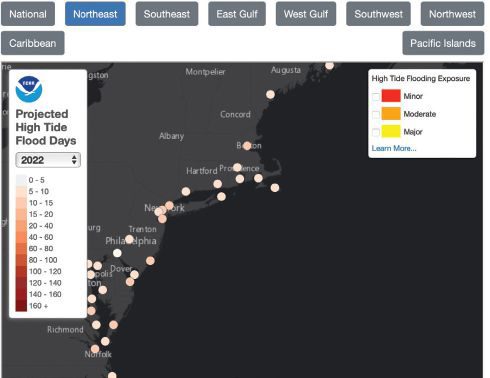September 2022 Trends

National Groups Partner to Highlight Engineering, Public-Works Projects

The American Council of Engineering Companies (ACEC), American Public Works Association (APWA) and American Society of Civil Engineers (ASCE) announced a nationwide partnership and awareness effort to highlight the meaningful, transformational work of engineers and public-works professionals.
During the coming months, “Infrastructure Works—An Engineering and Public Works Roadshow” will focus the public’s attention on industry projects that improve climate resiliency, ensure the delivery of clean air and water, promote energy efficiency, and open access to mobility.
According to the ACEC Research Institute, the bipartisan infrastructure bill Congress passed in 2021 is expected to add more than 82,000 full- and part-time jobs in engineering, public works and design services during the next five years. Finding the professionals to fill these roles is critical at a time when workforce shortages are already threatening the timely and successful completion of essential construction and design projects across the nation.
The importance of filling the talent pipeline for engineering and public-works jobs has been underscored by the Biden Administration’s announced summer-long “Talent Pipeline Challenge.” The Roadshow campaign will help amplify this effort with students and future employees by showcasing the dynamic projects engineering and public-works professionals design across the country.


According to an annual report released by the National Oceanic and Atmospheric Administration (NOAA), high-tide flooding (HTF)—often referred to as “king tides,” “nuisance” or “sunny day” flooding—is becoming increasingly common due to years of sea-level rise. HTF is defined as the overflow or excess accumulation of ocean water at high tide that covers low-lying areas, and typically occurs when tides reach anywhere from 1.75 to 2 feet above the daily average high tide and start spilling onto streets or bubbling up from storm drains. As sea-level rise continues, damaging floods that happened decades ago only during a storm now happen more regularly, such as during a full-moon or with a change in prevailing winds or currents.
Coastal communities across the United States continue to experience more-frequent high-tide flooding, forcing residents and visitors to deal with flooded shorelines, streets and basements. Similar to 2022 meteorological conditions, many regional HTF frequencies were lower, likely related to continued effects of La Niña.
The 2022 Outlook is enhanced by methods outlined in the U.S. Federal Sea Level Rise and Coastal Flood Hazard Task Force’s “2022 Sea Level Rise Technical Report,” an inter-agency effort to update sea-level-rise scenarios to emphasize the amount of expected rise by 2050 to inform community-planning initiatives.
Read the full report, including interactive maps, at bit.ly/3QmXtOo.

InEight Inc. released its second annual “Global Capital Projects Outlook,” which draws insights from research conducted with 300 of the world’s largest capital project owners and contractor construction professionals across North America, Europe and APAC.
The research reveals that 99 percent of North American respondents—the highest globally—are either very or fairly optimistic about their organization’s growth prospects for 2022, up from 97 percent in 2021. Digital technologies (54 percent) offer the top opportunity for growth, but most (95 percent) North American respondents said their experience of change management left room for improvement, signaling a need for a more-sophisticated, human-centric approach to technology implementation.
Tracking the global sentiment, North American respondents identified uneven or sporadic implementation (55 percent), process and data integration issues (54 percent), and technical and system limitations (49 percent) as the top frustrations caused by technology upgrades. North American respondents also were most likely to say that legacy ways of working prevent them from adopting new tools and processes.
The full report can be downloaded from bit.ly/3C0Rqe3.
Study Examines Role of Smart Cities in Urban Decarbonization
Cities account for more than 50 percent of the planet’s population and are responsible for more than 70 percent of global carbon emissions. To combat this, decarbonization strategies are being employed by cities worldwide. According to ABI Research’s “Urban Decarbonization Strategies and the Role of Smart Cities” report, technologies such as digital twins, IoT and AI will be critical assets for such transformation.
Examples of cities deploying technologies to enable decarbonization include London’s recent expansion of its Ultra Low Emission Zone (ULEZ), which uses a variety of technologies to assess the impact of new regulations. Another example is the Tengah, Singapore, innovation district, which uses a variety of technologies to support decarbonization, including a centralized cooling system, smart streetlights, smart waste removal, a mobile app for citizens’ smart meters, and mass rapid transport with a car-free city center. These strategies have a direct impact on energy consumption while encouraging and enabling citizens to make better choices to help the city decarbonize.
The report can be purchased at bit.ly/3zLjoaW.
TOP Stories
The following are the top stories from the last few months (in terms of traffic) on the Informed Infrastructure website. This also reflects key coverage areas that are regularly refreshed online and via our weekly e-newsletter. Simply search key words on Informed Infrastructure online to find the full story.
Buildings
- Johnson Controls Launches 2022 Sustainability Report
- Perkins&Will Breaks Ground on The Dallas College Eastfield Student Success Center
- New Orleans Ernest N. Morial Convention Center Completes Ambitious Series of Energy Saving Initiatives
- GE Inaugurates World-Class 3D Printing Facility Based on New COBOD Printer
- Empire State Building Goes Green
Transportation
- Woolpert, Righter Co. Receive ABCD Special Purpose Bridge Award for Mohican Cable Pedestrian Bridge
- FAA Updates Airport Design Guidance
- Video: Active Transportation Programs Getting Major Federal Investment
- IMSA Announces Ambitious Plan to Overhaul Certification Programs and Business Practices
- Video: Animated Maps: Electric Vehicle Charging Stations and U.S. Interstates, 2022
Water
- Digital Twins: Bringing the Future to Water Management
- New ASCE Manual of Practice 151 Offers Guidance for Sustainable Planning and Design of Water Pipelines
- Rice Process Aims to Strip Ammonia from Wastewater
- Clarke Energy to Demonstrate Carbon Negative Carbon Capture System
- EPA Announces $22 Million WIFIA Loan to Modernize Wastewater Infrastructure in Englewood, Colo.
Tools and Technology
- Sphera Tackles Scope 3 Emissions Reporting with Launch of its Automated Life Cycle Assessment Solution
- Trinatracker Launches Supertrack, a Smart Tracker Control System That Increases Power Production by up to 3% to 8%
- InEight Launches Project Controls Solution to Manage Alternative Delivery Projects After Pilot Shows 10% Reduction in Design Costs
- Duke Energy One, L3Harris Offer New Operational Solution for Nuclear Power Plants
- North America Digital Twin Market Size to Surpass $1.5 Billion by 2026


